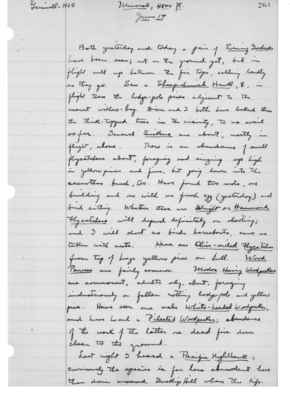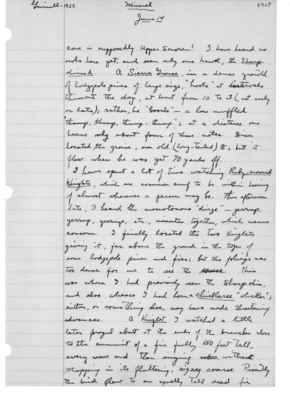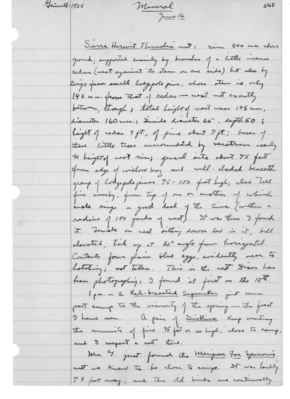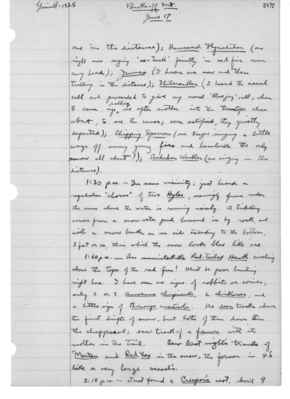Pages That Mention fir
1925: Joseph Grinnell's field notes
S2 Page 7
Collector: Grinnell - 1925 Location: Lassen Section (Mineral) Date: June 14, 1925 Page Number: 2463
Both yesterday and today a pair of Evening Grosbeaks have been seen; not on the ground yet, but in flight well up between the fir tops, calling loudly as they go. Saw a Sharp-shinned Hawk, female, in flight thru the lodge-pole pines adjacent to the nearest willow-bog. Dixon and I both have looked thru the thick-topped trees in the vicinity, to no avail so far. Several Siskins are about, mostly in flight, above. There is an abundance of small flycatchers about, foraging and singing up high in yellow pines and firs, but going down into the ceanothus bush, too. Have found two nests, one building and one with one fresh egg (yesterday) and bird sitting. Whether these are Wright or Hammond Flycatchers will depend definitely on shooting; and I will shoot no birds hereabouts, save any (?) taken with nests. Hear one Olive-sided Flycatcher from top of huge yellow pine on hill. Wood Pewees are fairly common. Modoc Hairy Woodpeckers are commonest, adults only, about, foraging industriously on fallen rotting lodge-pole and yellow pine. Have seen one male White-headed Woodpecker, and have heard a Pileated Woodpecker; abundance of the work of the latter on dead firs down clean to the ground. Last night I heard a Pacific Nighthawk; curiously this species is far less abundant here than down around Inskip Hill where the life-
S2 Page 8
Collector: Grinnell - 1925 Location: Lassen Section (Mineral) Date: June 14, 1925 Page Number: 2464
zone is supposedly Upper Sonoran! I have heard no owls here yet, and seen only one hawk, the Sharp shinned. A Sierra Grouse, in dense growth of lodgepole pines of large size, "hoots" at intervals thruout the day, at least from 10 to 3 (not early or late); rather, he "boonts" - a low muffled "thump, thump, thump, thump"; at a distance one hears only about four of these notes. Dixon located the grouse, an old (long-tailed) female, but it flew when he was yet 70 yards off. I have spent a lot of time watching Ruby-crowned Kinglets, which are common enuf to be within hearing of almost wherever a person may be. This afternoon late, I heard the monotonous "dinge", yerrup, yerrup, yerrup, etc., minutes together, which means concern. I finally located the two Kinglets giving it, far above in the tops of some lodgepole pines and firs; but the foliage was too dense for me to see the cause. This was where I had previously seen the Sharpshin, and also whence I had hear a chickadee "chicken"; either, or something else, may have made threatening advances. A Kinglet I watched a little later foraged about at the end of branches close to the summit of a fir fully 150 feet tall, every now and then singing without stopping it its fluttering, zigzag course. Presently the bird flew to an equally tall dead fir
S2 Page 12
Collector: Grinnell - 1925 Location: Lassen Section (Mineral) Date: June 16, 1925 Page Number: 2468
Sierra Hermit Thrushes nest: rim 800 mm above ground; supported mainly by branches of a little incense cedar (nest against its stem on one side) but also by twigs from small lodgepole pine, whose stem is only 145 mm. from that of cedar - nest not exactly between, though; total height of nest was 145 mm., diameter 160 mm.; divide diameter 65, depth 50; height of cedar 4 ft., of pine about 7 ft.; bases of these little trees surrounded by veratrum nearly to height of nest rim; general site about 75 fee from edge of willow bog and well-shaded beneath group of lodgepole pines 75-100 feet high; also tall firs nearby, from tip of one or another of which male sings a good deal of the time (within a radius of 100 yards of nest). It was thus I found it. Female on nest sitting down low in it, bill elevated, tail up at 80° angle from horizontal. Contents four plain blue eggs, evidently near to hatching; not taken. This is the nest Dixon has been photographing; I found it first on the 13th. 1 p.m. - a Red-breasted Sapsucker just came past camp to the vicinity of the spring - the first I have seen. A pair of Siskins keep visiting the summit of firs 75 feet or so high, close to camp, and I suspect a nest there. Mrs. G just found the Mariposa Fox Sparrow's nest we knew to be close to camp. It was hardly 75 feet away, and the old birds are continually
S2 Page 13
Collector: Grinnell - 1925 Location: Lassen Section (Mineral) Date: June 16, 1925 Page Number: 2469
feeding about our campsite. The male has frequently sung from a young fir tip scarcely ten feet directly above the nest, also from the brush all about it, and when hopping on the ground between or thru the bushes. The rim of the nest is 360 mm. above a mat of yellow pine needles; the nest itself is ensconced among the leaning stems of a rather sparse ceanothus integerrimus. It is a large structure, of much coarse pine and other twigs externally, and lined with shredded bark. There are two young, about 3 days old I think, helpless and downy rather than feathery. The old female is very solicitous, coming within 6 feet of us when at the nest; but the male shows little concern, and sings volubly immediately we leave, from within 20 feet of the nest. Mountain Chickadee's nest, with young, in woodpecker hole opening on under side of a leaning stub a foot in diameter and some 15 feet long. Entrance just my height from the ground - 5 ft., 7 in.; diameter of entrance, 44 mm. - so probably was made by a White-headed Woodpecker. Site open, surrounded by dry ceanothus slope; some very small yellow pines nearby, also two yellow pine stumps, sawed off so long ago they are rotting, cleft. The old chickadees come with food freely, altho I am only about 15 feet away under a bush on the dry (?) hill side. Each bird dives directly into the hole, as it arrives,
S2 Page 17
Collector: Grinnell - 1925 Location: Lassen Section (Brokeoff Mt.) Date: June 17, 1925 Page Number: 2472
one in the distance); Hammond Flycatcher (one right now saying "see-Tuck" faintly in red fir over my head); Junco (I hear one now and then trilling in the distance); Nutcracker (I heard the nasal call and proceeded to give my usual "bluejay" call, when 5 came up, calling, one after another into the treetops close about, to see the cause; soon satisfied, they quietly departed); Chipping Sparrow (one keeps singing a little way off away young firs and hemlocks the only snow all about!); Audubon Warbler (one singing in the distance). 1:30 p.m. - In same vicinity; just heard a regulation "chorus" of two Hylas, seemingly from under the snow where the water is running noisily. A tributary comes from a snow-water pond hemmed in by rock, and with a snow bank on one side extending to the bottom, 3 feet or so, thru which the snow looks blue like ice. 1:50 p.m. - An unmistakable Red-Tailed Hawk circling above the tops of the red firs! Must be poor hunting right here. I have seen no signs of rabbits or conies; only 2 or 3 Amoenus Chipmunk, 2 chickadees, and a little sign of Thomomys monticola. No deer tracks above the first drifts of snow, but lots of them down thru the chaparral; saw track of a fawn with its mother in the trail. Saw last night's tracks of Marten and Red Fox in the snow, the former in 4's like a very large weasel's. 2:15 p.m. - Just found a Creeper's nest, about 9




